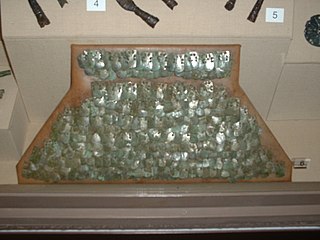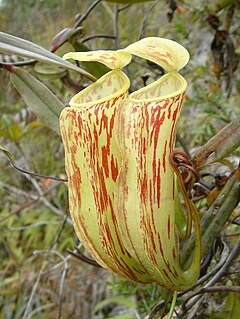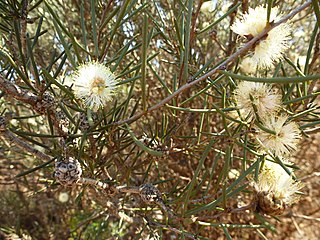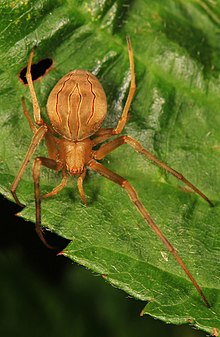
The lorica squamata is a type of scale armour used by the ancient Roman military during the Roman Republic and at later periods. It was made from small metal scales sewn to a fabric backing. No examples of an entire lorica squamata have been found, but there have been several archaeological finds of fragments of such shirts and individual scales are quite common finds—even in non-military contexts.

Nepenthes hamata is a tropical pitcher plant endemic to Sulawesi, where it grows at elevations of 1400–2500 m above sea level.

Nepenthes glabrata is a tropical pitcher plant endemic to Sulawesi. The species grows in open, high forest at elevations of 1600 to 2100 m. It produces dainty, colourful pitchers reaching only a few centimetres in height. These traps are red speckled on a yellowish background, giving them a "hand painted" appearance.

Roman military personal equipment was produced in small numbers to established patterns, and used in an established manner. These standard patterns and uses were called the res militaris or disciplina. Its regular practice during the Roman Republic and Roman Empire led to military excellence and victory. The equipment gave the Romans a very distinct advantage over their barbarian enemies, especially so in the case of armour. This does not mean that every Roman soldier had better equipment than the richer men among his opponents. According to Edward Luttwak, Roman equipment was not of a better quality than that used by the majority of Rome's adversaries. Other historians and writers have stated that the Roman army's need for large quantities of "mass produced" equipment after the Marian Reforms and subsequent civil wars led to a decline in the quality of Roman equipment compared to the earlier Republican era:
"The production of these kinds of helmets of Italic tradition decreased in quality because of the demands of equipping huge armies, especially during civil wars...The bad quality of these helmets is recorded by the sources describing how sometimes they were covered by wicker protections, like those of Pompeius' soldiers during the siege of Dyrrachium in 48 BC, which were seriously damaged by the missiles of Caesar's slingers and archers."
"It would appear that armour quality suffered at times when mass production methods were being used to meet the increased demand ..." and "...the reduced size curiasses would also have been quicker and cheaper to produce, which may have been a deciding factor at times of financial crisis, or where large bodies of men were required to be mobilized at short notice, possibly reflected in the poor-quality, mass produced iron helmets of Imperial Italic type C, as found, for example, in the River Po at Cremona, associated with the Civil Wars of AD 69 AD; Russel-Robinson, 1975, 67"
"Up until then, the quality of helmets had been fairly consistent and the bowls well decorated and finished. However, after the Marian Reforms, with their resultant influx of the poorest citizens into the army, there must inevitably have been a massive demand for cheaper equipment, a situation which can only have been exacerbated by the Civil Wars..."

Neostenanthera hamata is a species of plant in the family Annonaceae. It is found in Ivory Coast, Ghana, Liberia, and Sierra Leone. George Bentham, the English botanist who first formally described the species, using the basionym Oxymitra hamata, did not explicitly explain the specific epithet, but it has distinctive outer petals with hooked tips.
Culoptila is a genus of caddisflies found primarily in Central America as well as the United States.

Officially Sochut Dendropark named after Edmund Leonowicz, commonly knowns as Stepanavan Dendropark, is an arboretum located near the Gyulagarak village, Lori Province, Armenia. Located around 85 km north of the capital Yerevan, the park was founded in 1931 by Polish engineer-forester Edmund Leonowicz. The arboretum is 35 ha in total of which 17.5 ha consist of natural forest and 15 ha of ornamental trees.

Acacesia is a genus of orb-weaver spiders first described by Eugène Simon in 1895. It contains six species with a mostly neotropical distribution, ranging from South America to Mexico. One species, A. hamata, is found in the US as well.

Stylosanthes is a genus of flowering plants in the legume family, Fabaceae and contains numerous highly important pasture and forage species. It was recently assigned to the informal monophyletic Pterocarpus clade of the Dalbergieae. The common name pencilflower is sometimes used for plants in this genus.

Navarretia hamata is a species of flowering plant in the phlox family known by the common name hooked pincushionplant.
Clarkeulia hamata is a species of moth of the family Tortricidae. It is found in Peru.
Epeiromulona hamata is a moth of the subfamily Arctiinae. It was described by William D. Field in 1952. It is found in Trinidad, northern South America and Brazil.

Melaleuca hamata is a plant in the myrtle family, Myrtaceae and is endemic to the south-west of Western Australia. It grows to a large, dense shrub with broombrush foliage and profuse pale yellow flowers in late spring.
Nepenthes maryae is a tropical pitcher plant native to Central Sulawesi province on the Indonesian island of Sulawesi. It is known from a single herbarium specimen collected in 2000 on an undisclosed mountain at 2100 m above sea level, where the species grew in submontane mossy forest alongside N. eymae, N. nigra, and N. tentaculata. It is a member of section Tentaculatae, which also includes 8 other species from Borneo and Sulawesi: N. glabrata, N. hamata, N. muluensis, N. murudensis, N. nigra, N. pitopangii, N. tentaculata, and N. undulatifolia. Nepenthes maryae is distinguished from all other species in this group by the presence of short hairs on the lower surface of the pitcher lid and bracts on the majority of flowers.
Ellipsoptera hamata, the coastal tiger beetle, is a species of flashy tiger beetle in the family Carabidae. It is found in Central America and North America.
Syneta hamata is a species of leaf beetle. It is found in western North America.
Phyllophaga hamata is a species of scarab beetle in the family Scarabaeidae. It is found in North America.
Diapterna hamata is a species of aphodiine dung beetle in the family Scarabaeidae. It is found in North America.
Paraproba hamata is a species of plant bug in the family Miridae. It is found in North America.
Eucera hamata is a species of long-horned bee in the family Apidae. It is found in North America.










